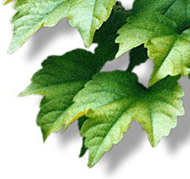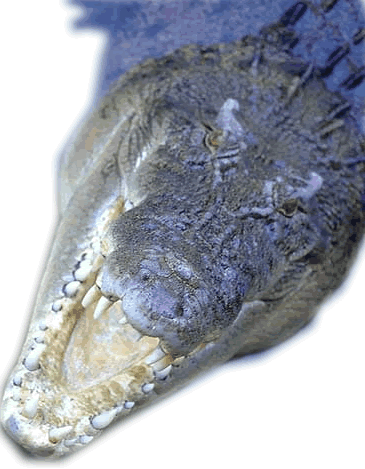



Description
Largest living crocodilian species with a confirmed measurement, and in fact the world's largest living reptile in terms of mass. Adult males can reach sizes of up to 6 or 7 metres (20 to 23 feet), the largest confirmed individual being 20.7 feet (6.3 metres). There is always a lot of interest over the largest ever recorded saltie. In general, males over 5 m (17 feet) in length are extremely rare. Females are smaller, the normal maximum adult size being 2.5 m to 3 m (8 to 10 feet) being the normal maximum adult size. Maximum weight varies, but has been known to exceed 1,000 kg in 18 to 19 foot adults. 5 metre adults are closer to 400 to 500 kg. This is a large-headed species with a heavy set of jaws. A pair of ridges run from the eye orbits along the centre of the snout, becoming more distinct with age. The upper surface of the top jaw becomes very rugose in large adult males. Scales on the flanks are more oval in shape than other species, although belly scales are rectangular, even and relatively small. Osteoderms are restricted to the back and a small nuchal cluster on the neck. Juveniles are normally pale tan in colour with black stripes and spots on the body and tail. A small percentage of animals in some regions tend to be much lighter in colour (hypomelanistic), although very dark (hypermelanistic) animals are occasionally also seen. The juvenile colouration persists for several years, growing progressively paler and less colourful with more indistinct bands which never completely disappear, although are rarely visible in adults except in clear water. Mature adults are generally dark, with lighter tan or grey areas. The ventral surface (belly) is creamy yellow to white in colour, except the tail which tends to be more grey on the underside nearer the tip. Dark bands and stripes are present on the lower flanks, but do not extend onto the belly region.
Distribution:
Australia, Bangladesh, Brunei, Myanmar (Burma), Cambodia, China, India (including Andaman Islands), Indonesia, Malaysia, Palau (Caroline Islands) , Papua New Guinea, Philippines, Singapore, Sri Lanka, Solomon Islands, Thailand, Vanuatu (Banks Islands), Vietnam. Single individuals can be found some distance from their usual range (e.g. Japan, islands in the Indian Ocean), as they can travel long distances (over a thousand km) by sea - barnacles have been found on the scales of a few stray individuals. This sea-faring ability probably helps to explain their wide distribution. Historically present on the Seychelles islands (now extinct).
Habitat
As its name implies, this species has a high tolerance for salinity, being found in brackish water around coastal areas and in rivers. However, it is also present in freshwater rivers, billabongs and swamps. Movement between different habitats occurs between the dry and wet season, and as a result of social status - juveniles are raised in freshwater areas, but eventually sub-adult crocodiles are usually forced out of these areas (used for breeding by dominant, territorial adults), into more marginal and saline areas. Subordinate animals unable to establish a territory in a tidal river system are either killed or forced out into the sea where they move around the coast in search of another river system
Reproduction
Breeding territories are established in freshwater areas. Females reach sexual maturity at lengths of 2.2 to 2.5 m (10 to 12 years old). Males mature later (3.2 m, at around 16 years old). 40 to 60 eggs are usually laid (can range from 25 to 90) in mound nests made from plant matter and mud. These are constructed between the months of November and March during the wet season - this serves to raise the eggs above the ground to help prevent losses due to flooding. Many nests are still flooded every year, however, killing all the unhatched embryos. Alternately, if the nest is in danger of getting too dry, the female has apparently been observed to splash water onto it from a purpose-dug, adjacent pool. Although the female stays near the nest, some eggs do fall foul of predators (e.g. monitor lizards, feral wild pigs in Australia) and human egg collectors. Juveniles hatch after around 90 days, although this varies with nest temperature. The female digs the neonates out of the nest when they start their characteristic chirping sounds, assisting them to the water by carrying them in her mouth. Much research has been carried out into TSD (Temperature-dependant Sex Determination) in this species, which is of value for captive breeding programs to ensure the correct sex ratio, or to produce faster growing males for farming purposes. The highest percentage of males are produced around 31.6°C, with more females a few degrees above and below this. It is estimated that less than 1% of hatchlings will survive to reach maturity, given predation (e.g. turtles, goannas, C. johnstoni) and social pressures (territorial males will kill and eat juveniles - they are one of the main limiting factors in population growth along with competition).
Diet
Saltwater crocodiles take a wide variety of prey, although juveniles are restricted to smaller items such as insects, amphibians, crustaceans, small reptiles and fish. The larger the animal grows, the greater the variety of items that it includes in the diet, although relatively small prey still make up the majority of the diet even in large adults. Prey items include crustaceans (e.g. mudcrabs) and vertebrates (e.g. turtles, goannas, snakes, shore and wading birds). Large adults occasionally take much larger prey include buffalo and domestic livestock, wild boar, monkeys etc.


